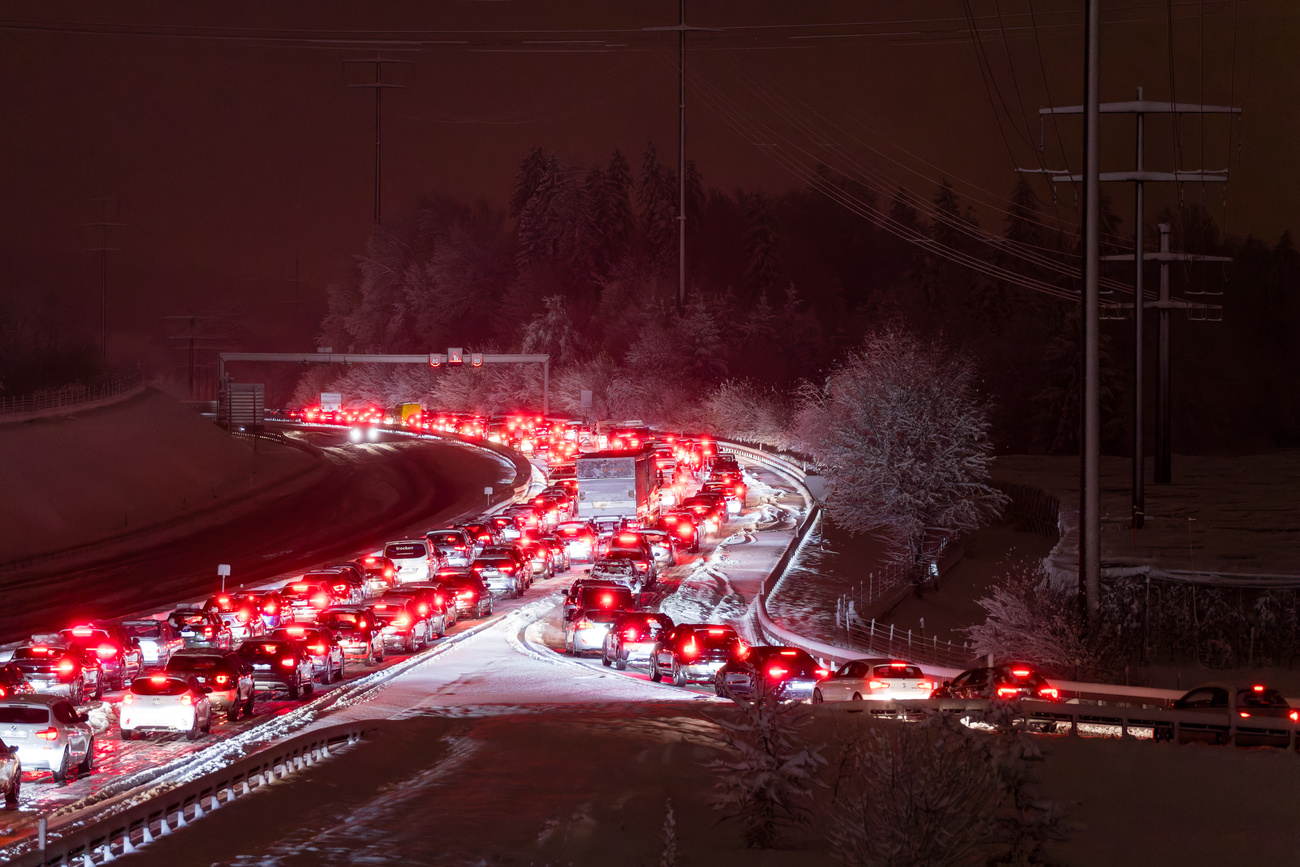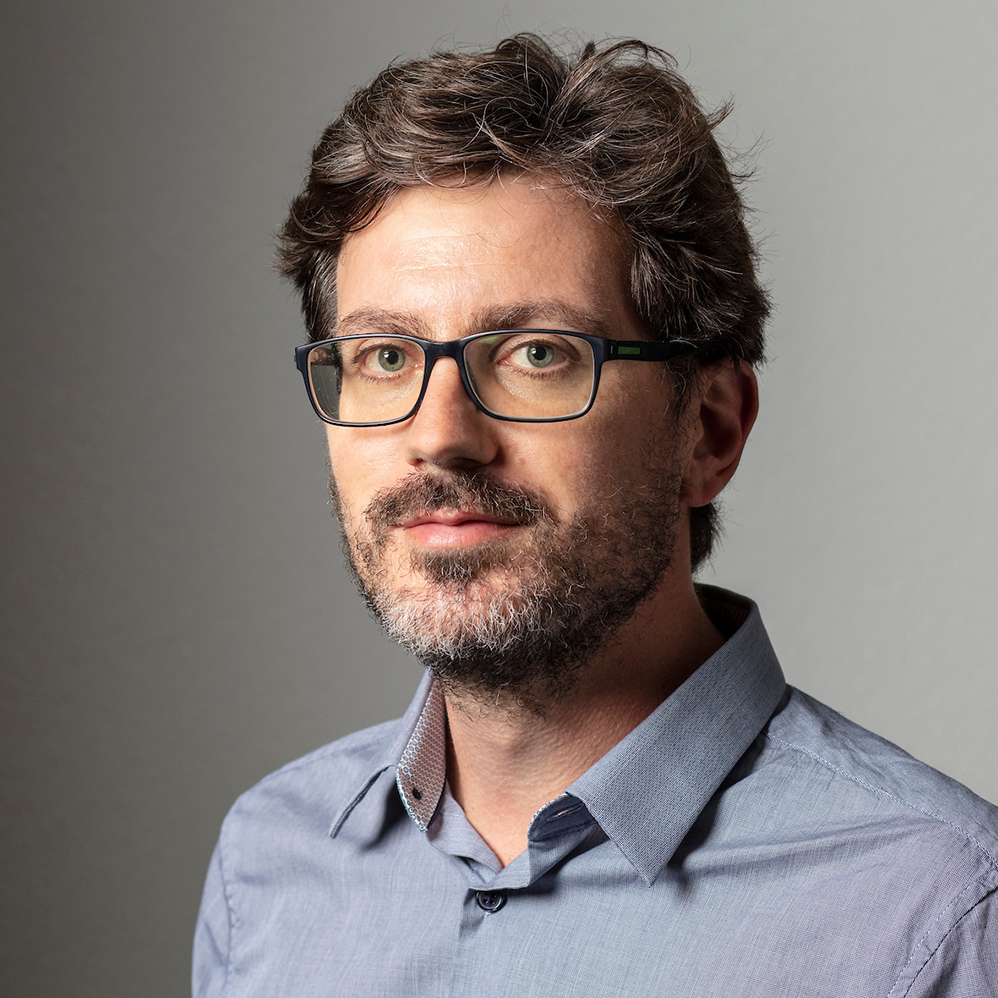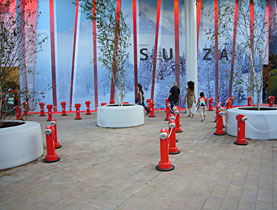Swiss meadow to flower in Shanghai

The Swiss Pavilion at the Shanghai Expo promises to give visitors an uplifting experience, transporting them to a rooftop alpine meadow.
But before this can happen, the Swiss team have some hurdles to overcome, not least of which is liberating some all-important chairlifts from customs. They have ten weeks left to create Swiss paradise.
Under the motto “interaction between city and countryside”, the Swiss Pavilion aims to draw visitors in with familiar Swiss stereotypes – mountains, cows, raclette, watches, chocolate – and then dazzle them with a presentation of innovative Switzerland.
“It’s about attracting visitors with the beauty of the landscape they know, but to go beyond the clichés and show them other realities, to underline other strengths,” explained Anne-Sophie Cosandey, head of the Swiss project in Shanghai.
It’s a far cry from the provocative slogan of the Swiss Pavilion at Seville in 1992 – “Switzerland does not exist”. “Our goal is not to criticise but to show what we know how to do,” Casandey said.
Case in point: the chairlift, which promises to be a big hit. It will offer visitors a four-minute ride which will bring them to the roof of the pavilion, covered in a flowering meadow.
Success guaranteed
“We’ll have plants which are common in Switzerland but also found in China. We initially thought of having sheep grazing up there,” Cosandey said. “But the idea was abandoned , the gardeners already had enough work to do.”
The gardeners have already done a test run.
“For the last year and a half we have been carrying out tests, we planted a small meadow on the roof of a Shanghai apartment building and it was a surprise to learn that we would have to replant twice during the six months of the Expo.”
With less than three months until the Expo opens, the roof of the pavilion looks far from idyllic.
But the view of Shanghai, the Huangpu river, and the other pavilions is breathtaking and gives an indication of the success the installation will be among the hoards of visitors, keen to steal a few minutes of respite in this oasis of calm and greenery.
The chosen few
China has promised to select 15 national pavilions which it judges to be the most successful and to rebuild them elsewhere after the exhibition. Switzerland – which incidentally celebrates 60 years since establishing diplomatic relations with communist China this year – has made no secret of its ambition to be among the final 15.
But there’s still some way to go. Three months from D-day “some of the chairlifts are stuck at customs, no way to get them released,” Cosandey said.
“We are confronted with a host of administrative problems, it’s not always easy to sort things out.”
Gao Pan, who is in charge of the building site on behalf of the Nüssli Group is unruffled, despite being new to the world of chairlifts.
“Everything is perfectly on time. I have lots of experience in structural questions, interior decoration … but a chairlift for me is really a first. I hope we can make the first tests from mid-February.” The installation will be able to transport 1,500 people per hour.
Role of the lift
The lift plays a key role in the Swiss experience. Access to the Swiss Pavilion will be regulated by the chairlift, meaning the pavilion can only accommodate 20,000 visitors per day. “We are almost certainly going to be operating at full capacity, ” Cosandey said.
A maximum of 3.6 million people can therefore visit the Swiss Pavilion, while the Chinese organisers are estimating visitor numbers from 70 million to 100 million.
Long queues are to be expected then. People waiting in line will be provided with informative displays from Swiss Tourism, an interactive game on Switzerland, cool water and parasols.
Those who persevere in the queue will discover the innovative power of Switzerland through the 3D binoculars, they will hear from 12 Swiss, well-known and unknown, expressing their dreams and visions on a small screen and see an IMAX film on the beauty of the Alps projected onto a giant screen.
And those who don’t want to wait will be able to enter through an interactive façade to reach the urban space of the pavilion to take advantage of a restaurant, the MontreuxJazz café, the Swatch shop and the different entertainment going on. VIPs will have their own lounge with a bar and view over the Alps, courtesy of an IMAX display.
For the long term
“Our conference hall will be dedicated to developing the theme of the pavilion, the interaction between city and countryside, as well as the four sub-themes: quality of air, quality of water, sustainable technology and construction, and public transport,” Casandey explained.
And the investment of SFr25 million ($23.46 million), in public-private partnership, will that also be sustainable?
“On the one hand we hope to be one of the 15 pavilions asked to stay on. On the other hand it’s clear that what we undertake today is for tomorrow. The collaborations that we set up now, for example, with the universities, will serve to create long-term links.”
Alain Arnaud in Shanghai, swissinfo.ch (translated from French by Clare O’Dea)
The restaurant at the Swiss pavilion will have about 130 seats and will serve Swiss specialities, including raclette and Zürcher Geschnetzeltes, but Chinese cuisine, too.
Instead of Western cutlery, customers will receive chopsticks.
A cafe called MontreuxJazz , will offer coffee and room for music. The MontreuxJazz is in the process of selecting Swiss groups to perform at the pavilion.
From May 1 to October 31, 2010, the World Expo in Shanghai will be held under the motto “Better City, Better Life”.
Switzerland’s pavilion deals with one of the exhibition’s sub-themes, “The interaction between city and countryside“.
During the exhibition, about one hundred people will work for the Swiss pavilion. Hiring is complete, and all the staff – Swiss and Chinese –are fluent in English, Chinese and at least one Swiss national language.
95% of visitors to the Expo are expected to be Chinese. The Swiss employees who receive them must be able to communicate. They are either students or graduates in Chinese studies, or Swiss who live in China.
The 5% foreign visitors will be greeted in their language or in English.

In compliance with the JTI standards
More: SWI swissinfo.ch certified by the Journalism Trust Initiative











You can find an overview of ongoing debates with our journalists here . Please join us!
If you want to start a conversation about a topic raised in this article or want to report factual errors, email us at english@swissinfo.ch.